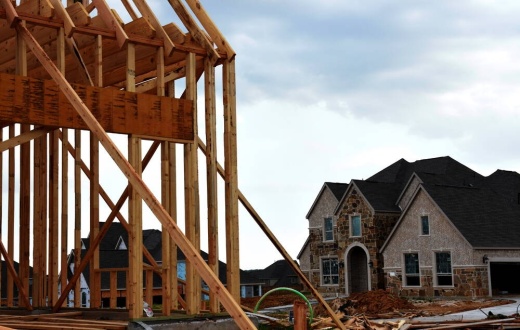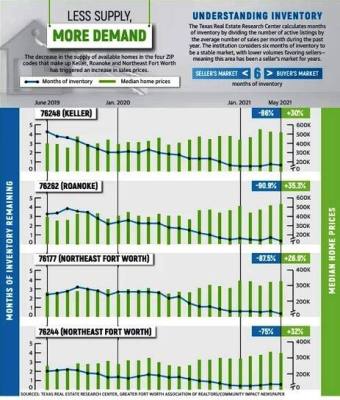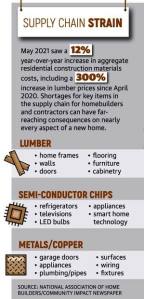“I have [clients] that have just decided to stay,” Eiland said. “We couldn’t find anything that worked for them and what they were willing to pay. Or, we put offers on houses and got outbid. So, they’ve decided to stay now. One of them, I know, has completely remodeled their house ... another one is just saying, ‘We’ll wait till next year.’”
According to data from the Greater Fort Worth Association of Realtors, there were 71% fewer homes on the market in May 2021 than in May 2020 within the four ZIP codes—76248 in Keller, 76262 in Roanoke, and 76177 and 76244 in Northeast Fort Worth—that make up the coverage area for this edition of Community Impact Newspaper.
Within those ZIP codes, GFWAR data reflects a sharp decline in the average amount of time homes are staying on the market—as few as seven days in Keller, for instance, down from 35 days a year ago.
The Texas Real Estate Research Center tracks months of inventory, with drops in supply favoring sellers. In May of 2018, for instance, there were 3.2 months of inventory in Keller and 2.4 months in Roanoke. Within the past calendar year, the metric has dipped below one month throughout the market.
Taken together, the high demand and low inventory are having a profound impact on the local market. In some ways, it also has become a cyclical dynamic. Darin Davis is a Realtor residing in Roanoke, and said the shortage has been affected by would-be sellers who are wary of becoming buyers.
“If they don’t have a second home, or maybe a rental home ... that they’re willing to move into, they’re just hitting the pause button,” Davis said. “Folks are just saying to themselves, ‘If we sell, that’s great. We’re going to walk away with a healthy profit—but we’re going to have to go spend all that and then some to move.’”
Leveling off
Soaring prices remind many of the mid-2000s before the Great Recession—but Jim Gaines, an economist for the Texas Real Estate Research Center, points out a key distinction.
“The factor that was going on there ... was the exuberance of lenders—just making loans available and defying what would be called sound lending principles,” Gaines said. “That was a bubble. We don’t think that’s what’s happening today. ... As a matter of fact, the statistics ... indicate that lenders are actually being even more restrictive—they’re requiring a higher [credit] score, a lower debt-to-income ratio.”
Because of this, Gaines said many in his profession do not think the market is in the midst of a housing bubble or at risk of a sudden downturn. In fact, though he anticipates an eventual leveling off, Gaines said when that will happen is hard to pinpoint.
“No one expects the rate of increases that we’ve seen the past year to sustain for much longer,” he said. “Now, I don’t know how long ‘much longer’ is. It’s more than a couple of months and less than three years—how’s that?”
One reason Gaines doesn’t think a leveling off is imminent is due to the challenges facing homebuilders.
According to the National Association of Home Builders, 2020 saw a 12% year-over-year increase in aggregate residential construction materials costs. These complications have slowed construction of new housing, which could help alleviate pressure in the region. The challenges have extended beyond lumber, too, and according to Gaines there is also a skilled labor shortage.
“It’s not just that you can hire anybody to go around the house,” he said. “It’s helpful that they are either a carpenter, an electrician, a plumber.”
A desired market
Both Eiland and Davis note that many buyers, despite the challenges of the market, still want to be in Keller-Roanoke-Northeast Fort Worth—an area where space for new homes is becoming more limited.
Kelly Carlson, a senior planner for the city of Roanoke, reports the city is nearing total build-out on single-family homes. There is one development of 11 houses proposed and some potential multifamily projects in the works, Carlson said. Corresponding with dwindling land available, the volume of residential building permits in Roanoke has decreased from 174 in 2015 to 56 in 2020.
In Keller, 81.6% of land zoned for traditional residential uses—such as single-family and patio homes—has been developed, according to Rachel Reynolds, a city spokesperson. Similar to Roanoke, permits for single-family new builds have dropped in Keller from 227 in 2015 to 82 in 2020.
According to Jane Mathews, a planner for the city of Fort Worth, land left in ZIP codes 76177 and 76244 that is both vacant and zoned for residential uses accounts for just 2% of the total land in each respective ZIP code—translating to 234 acres available in 76177 and 227 acres in 76244.
According to Eiland and Davis, even within the competitive landscape of the metroplex, this market continues to stand out for many families.
“Quality of life, quality of schools ... safety and parks,” Davis said. “It’s just tough to beat the Keller, Roanoke and far north Fort Worth area.”







